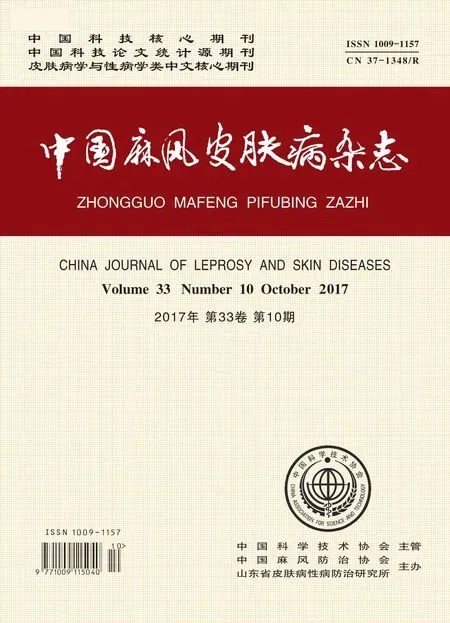TNF-α與關節病型銀屑病
師 蓓 任萬明 王亞婷
蘭州大學第一醫院皮膚性病科,蘭州,730000
任萬明,E-mail:rwm543@sina.com
TNF-α與關節病型銀屑病
師 蓓 任萬明 王亞婷
臨床中通過阻斷TNF-α治療關節型銀屑病有效,因此TNF-α可能在PsA的發病中起重要作用,本文對TNF-α在關節病型銀屑病中的作用機制做一綜述。
腫瘤壞死因子α; 關節病型銀屑病
關節病型銀屑病(psoriatic arthritis,PsA)是銀屑病的關節損害,其特點是受累關節紅腫、疼痛、活動受限。目前PsA發病機制尚未明確,可能與銀屑病有著共同的發病機制。腫瘤壞死因子α(TNF-α)由單核吞噬細胞、中性粒細胞、NK細胞、活化的淋巴細胞、血管內皮細胞以及其他細胞產生,具有廣泛的生物學活性,是巨噬細胞被脂多糖和其他細菌產物活化后分泌的一種重要的炎癥性細胞因子,也可引起白細胞增多,內皮細胞黏附性增強,是中性粒細胞功能的啟動因子,還可促進其他細胞因子,特別是急性期反應物的產生。臨床中通過阻斷TNF-α治療PsA有效,TNF-α可能在PsA的發病機制中起重要作用。
1 機制
1.1 細胞間黏附分子 TNF-α可刺激角質形成細胞與內皮細胞產生細胞間黏附分子1(intercellular adhesion molecule 1,ICAM-1)[1],ICAM-1是一種淋巴細胞功能相關抗原1(lymphocyte function-associated antigen-1,LFA-1)配體,該配體與T細胞表達的細胞表面抗原結合,從而使T細胞與角質形成細胞、內皮細胞相互作用。黏附分子的增加會增加T細胞與這些細胞結合的機會,使T細胞浸潤到表皮。
除了增加細胞間黏附分子使T細胞浸潤到表皮,血管生成也可以為T細胞提供一個進入表皮的途徑。血管生成是由多種因子刺激的,其中最重要的因子是血管內皮生長因子(vascular endothelial growth factor,VEGF)。已證明TNF-α誘發角質細胞VEGF mRNA的表達,這個過程依賴于在皮膚產生的一氧化氮。TNF-α還可通過誘導型一氧化氮合酶增加皮膚一氧化氮含量[2],因此,TNF-α可直接增加VEGF以及誘導VEGF依賴的一氧化碳的產生。隨著新血管的產生,進入表皮的T細胞增加。
1.2 補體系統 研究發現,TNF-α通過增加人肝細胞系因子B和C3的合成與補體系統相互作用[3]。評估單獨使用抗TNFα制劑治療PsA患者,可觀察到患者C3和C4水平的顯著下降,其中C3水平顯著下降的患者對抗TNF-α制劑的療效良好,基礎C3低水平的患者有更好的療效[4]。
在急性反應期TNF-α通過提高肝細胞補體蛋白的合成與補體系統相互作用[3],TNF-α和補體系統的相互作用可能是PsA發病的作用途徑,減少補體激活可能是TNF-α抑制劑在炎癥性關節炎發揮作用的一個機制。由于這些發現,補體可能是在關節病型銀屑病和關節炎中有效的治療靶點。
1.3 TNF-α受體 TNF-α有p55和p75兩種受體,p55受體是一個55 kDa的蛋白稱為TNF-RI。p75受體是一個75 kDa的蛋白稱為TNF-RII。與TNF-RI相比,TNF-RII有較高的親和力與解離率。
TNF-RI介導TNF-α的許多作用,包括激活NFkB、T細胞的增殖、產生Th1細胞因子[5,6]。使用單克隆和多克隆抗體后,正常人和銀屑病患者的角質形成細胞和真皮上層樹突狀細胞都含有TNF-RI。而在銀屑病患者中TNF-RI在真皮淺層血管和角質層中增加[7]。此外,與非銀屑病人群的血漿相比,銀屑病患者血漿中可溶性TNF-RI增加。可溶性TNF-RI能拮抗TNF-α活性,但它同時可誘導內皮細胞生長[8],導致血管生成和促進表皮T細胞入侵。與TNF-RI相比,TNF-RII可以介導細胞對TNF-α產生不同作用,如朗格漢斯細胞向淋巴結遷移以及T細胞增殖和細胞因子的產生等類似作用[9]。研究發現,正常人的小汗腺導管和真皮樹突狀細胞有TNF-RII,而表皮沒有。和TNF-RI一樣,TNF-RII在真皮淺層血管和皮損處角質層中增加[7]。
TNF-α一旦合成、釋放,并結合自身受體后,會以多種方式上調炎癥反應,TNF-α可誘導角質形成細胞和內皮細胞黏附分子的表達[10],對趨化因子的產生有上調作用,這種上調黏附分子和趨化因子的結果,就是募集更多的炎性細胞至皮損,進一步產生細胞因子,包括TNF-α,從而放大整個過程[11]。
研究發現可溶性TNF-RI和TNF-RII存在于風濕性疾病患者的血清和關節液中,并被認為是內源性TNF抑制劑。關節滑膜液分析顯示PsA患者的可溶性TNF-RI和TNF-RII水平顯著高于骨關節炎患者,但低于類風濕性關節炎患者[12]。
1.4 細胞因子 TNF-α可增加白介素(interleukin,IL)-1,IL-6,IL-8和核轉錄因子B(nuclear transcription factor B,NFB)的產生[13,14]。這些炎性細胞因子可通過刺激T細胞和角質形成細胞而合成[15],并在銀屑病發病機制中發揮作用。
體外研究發現[16],阻斷TNF-α能夠使類風濕性關節炎(Rheumatoid arthritis,RA)滑膜中IL-1,IL-6,IL-8和粒細胞巨噬細胞集落刺激因子等炎性細胞因子減少。這表明TNF-α在滑膜炎癥的調節中起著核心作用。TNF-α抑制劑治療RA的臨床試驗中,臨床表現和影像學參數顯著改善,滑膜的炎性細胞浸潤明顯減少[17],開創了風濕性疾病靶向治療時代。
1.5 破骨細胞 PsA患者關節損害的細胞因子模式與皮膚中的相似,滑膜免疫組織病理研究發現,滑膜組織肥大是由T細胞、巨噬細胞、單核細胞、成纖維細胞等浸潤引起,TNF-α、IL-1、IL-6等細胞因子的表達顯著增加,其可刺激炎性細胞的進一步增殖,軟骨細胞和成纖維細胞產生金屬蛋白酶和其它酶,并刺激破骨細胞成熟和活化,導致軟骨損害和骨侵蝕[18]。與在皮膚中相似,血管內皮生長因子的上調導致滑膜新血管顯著增生,并且比RA明顯。內皮細胞的細胞因子激活導致黏附分子的上調,并將炎癥細胞吸引到滑膜和附著點的炎癥部位[19]。
TNF-α誘導破骨細胞前體細胞和骨髓基質細胞表達TNF-RI,產生破骨細胞因子,例如IL-1、RANKL(NF-κB配體受體激活劑)和巨噬細胞集落刺激因子[20]。在一定水平的RANKL下,IL-1主導破骨細胞生成,并且誘導破骨細胞前體和骨髓基質細胞中的p38 MAP激酶活化,參與TNF-α介導的破骨細胞形成[20]。阻斷體內TNF-α可顯著抑制循環破骨細胞前體 (osteoclast precursors,OCP)的數目,高比率的RANKL與骨保護素表達使OCPs進入滑膜微環境,促進破骨細胞形成和骨吸收,表明了TNF-α在促進OCP形成中的關鍵作用[21]。
2 TNF-α制劑治療PsA
TNF-α抑制劑可改善患者外周、中軸關節以及附著點炎癥癥狀。還能改善患者功能狀態、生活質量和皮膚、指甲表現。TNF-α抑制劑治療已被證明能夠延緩外周關節損害的進展[22]。
美國FDA和其他全球衛生部門對PsA的治療批準五種TNF-α抑制劑:依那西普,英夫利昔單抗,阿達木單抗,戈利木單抗和賽妥珠單抗[23,24]。風濕病歐洲聯盟和銀屑病、銀屑病關節炎的評估與研究小組,為PsA患者推薦使用TNF-α抑制劑,推薦用于至少一種抗風濕藥治療PsA療效欠佳之后,也可被用來作為初始治療[25]。一項12~24周的隨機對照試驗證實TNF-α抑制劑治療PsA較安慰劑有更顯著的療效[26],根據美國風濕病學20%改善標準,TNF-α抑制劑治療PsA的好轉率為51%~59%,而安慰劑為9%~24.3%。并且TNF-α抑制劑可抑制影像學上病變的進展。比較英夫利昔單抗、阿達木單抗和依那西普治療PsA的臨床和實驗室指標,顯示這些藥物良好的療效,并且其有效性和安全性沒有顯著差異[27,28]。
3 結語
綜上可知,TNF-α通過多種環節參與PsA皮損及關節損害的產生和發展,其在本病中的作用非常重要,與其他細胞因子協同作用并貫穿于PsA發病機制中。阻斷TNF-α治療PsA取得良好的療效,說明其在本病發病機制中的重要作用。
PsA是臨床上常見疾病,其對患者身心健康及生活有很大影響,會造成勞動力降低甚至致殘,一般的治療控制欠佳、不良反應大,新型生物制劑的出現給患者帶來福音,但其價格昂貴,會增加感染機會,這都是需要結合患者考慮的因素,當然TNF-α只是免疫應答的一部分,不是唯一的途徑,是否有其他細胞因子抑制劑對PsA有更好的療效尚需大樣本實驗證實。隨著我們對PsA發病機制的理解,治療PsA藥物的選擇范圍也會擴大。
[1] Victor FC, Gottlieb AB, Menter A. Changing paradigms in dermatology: tumor necrosis factor alpha (tnf-α) blockade in psoriasis and psoriatic arthritis[J]. Clin Dermatol,2003,21(5):392-397.
[2] Yang ZS, Peng ZH, Xiao-Li LI, et al. Effect of curcumin on IL-17-induced nitric oxide production and expression of iNOS in human keratinocytes[J]. Chin J Cell Mole Immunol,2011,27(9):959-961.
[3] Pardo-Saganta A, Latasa MU, Castillo J, et al. The epidermal growth factor receptor ligand amphiregulin is a negative regulator of hepatic acute-phase gene expression[J]. J Hepatol,2009,51(6):1010-1020.
[4] Ballanti E, Perricone C, Muzio GD, et al. Role of the complement system in rheumatoid arthritis and psoriatic arthritis: Relationship with anti-TNF inhibitors[J]. Autoimmun Rev,2011,10(10):617-623.
[5] Richter F, Liebig T, Guenzi E, et al. Antagonistic TNF receptor one-specific antibody (ATROSAB): Receptor binding and in vitro bioactivity[J]. Plos One,2013,8(8):e72156.
[6] Chen X, Oppenheim JJ. Contrasting effects of TNF and anti-TNF on the activation of effector T cells and regulatory T cells in autoimmunity[J]. Febs Letters,2011,585(23):3611-3618.
[7] Moorchung NN, Vasudevan B, Chatterjee M, et al. A comprehensive study of tumor necrosis factor-alpha genetic polymorphisms, its expression in skin and relation to histopathological features in psoriasis[J]. Indian J Dermatol,2014,60(4):345-350.
[8] Sugano M, Tsuchida K, Tomita H, et al. Increased proliferation of endothelial cells with overexpression of soluble tumor necrosis factor receptor gene[J]. Atherosclerosis,2002,162(1):77-84.
[9] Eaton LH, Roberts RA, Kimber I, et al. Skin sensitization induced Langerhans' cell mobilization: variable requirements for tumour necrosis factor-α[J]. Immunology,2015,144(1):139-148.
[10] Gunawan RC, Almeda D, Auguste DT. Complementary targeting of liposomes to IL-1α and TNF-α activated endothelial cells via the transient expression of VCAM1 and E-selectin[J]. Biomaterials,2011,32(36):9848-9853.
[11] Kane D, FitzGerald O. Tumor necrosis factor-α in psoriasis and psoriatic arthritis: A clinical, genetic, and histopathologic perspective[J]. Curr Rheumatol Rep,2004,6(4):292-298.
[12] Mease PJ. Tumour necrosis factor (TNF) in psoriatic arthritis: pathophysiology and treatment with TNF inhibitors[J]. Ann Rheum Dis,2002,61(4):298-304.
[13] Mcinnes IB, Buckley CD, Isaacs JD. Cytokines in rheumatoid arthritis-shaping the immunological landscape[J]. Nat Rev Rheumatol,2016,12(1):63-68.
[14] Glowacka E, Lewkowicz P, Rotsztejn H, et al. IL-8, IL-12 and IL-10 cytokines generation by neutrophils, fibroblasts and neutrophils- fibroblasts interaction in psoriasis[J]. Adv Med Sci,2010,55(2):254-260.
[15] Senra L, Stalder R, Martinez DA, et al. Keratinocyte-derived IL-17E contributes to inflammation in psoriasis[J]. J Invest Dermatol,2016,136(10):1970-1980.
[16] Moelants EA, Mortier A, Van DJ, et al. Regulation of TNF-α with a focus on rheumatoid arthritis[J]. Immunol Cell Biol,2013,91(6):393-401.
[17] Palomino DC. Chemokines and immunity[J]. Einstein,2015,13(3):469-473.
[18] Schleicher SM. Psoriasis: Pathogenesis, Assessment, and Therapeutic Update[J]. Clin Podiatr Med Surg,2016,33(3):355-366.
[20] Katsuyama E, Miyamoto H, Kobayashi T, et al. Interleukin-1 receptor-associated kinase-4 (IRAK4) promotes inflammatory osteolysis by activating osteoclasts and inhibiting formation of foreign body giant cells[J]. J Biol Chem,2015,290(2):716-726.
[22] Hughes M, Chinoy H. Successful use of tocilizumab in a patient with psoriatic arthritis[J]. Rheumatology,2013,52(9):1728-1729.
[23] Nash P, Mease PJ, Mcinnes IB, et al. Secukinumab, a human anti-Interleukin-17A monoclonal antibody, improves active psoriatic arthritis and inhibits radiographic progression: efficacy and safety data from a phase 3 randomized, multicentre, double-blind, placebo-controlled study[J]. Internal Medicine Journal,2014,45(12):41-42.
[24] Kavanaugh A, van der Heijde D, McInnes IB, et al. Golimumab in psoriatic arthritis: one-year clinical efficacy, radiographic, and safety results from a phase III, randomized, placebo-controlled trial[J]. Arthritis Rheum,2012,64(8):2504-2517.
[25] Gossec L, Smolen JS, Gaujoux-Viala C, et al. European League Against Rheumatism recommendations for the management of psoriatic arthritis with pharmacological therapies[J]. Ann Rheum Dis,2012,71(1):4-12.
[26] Atteno M, Peluso R, Costa L, et al. Comparison of effectiveness and safety of infliximab, etanercept, and adalimumab in psoriatic arthritis patients who experienced an inadequate response to previous disease-modifying antirheumatic drugs[J]. Clinical Rheumatology,2010,29(4):399-403.
[27] Thorlund K, Druyts E, Avia-Zubieta JA, et al. Anti-tumor necrosis factor (TNF) drugs for the treatment of psoriatic arthritis: an indirect comparison meta-analysis[J]. Biologics,2012,6:417-427.
[28] Pharmad FC, Pharmad ADR, Pharmad CL, et al. Direct and indirect comparison of the efficacy and safety of adalimumab, etanercept, infliximab and golimumab in psoriatic arthritis[J]. J Clin Pharm Ther,2013,38(4):286-293.
Tumornecrosisfactoralphaandpsoriaticarthritis
SHIBei,RENWanming,WANGYating.
DepartmentofDermatovenereology,TheFirstClinicalHospitalofLanzhouUniversity,Lanzhou730000,China
RENWanming,E-mail:rwm543@sina.com
Through interfering TNF-α is effective in the treatment of psoriatic arthritis, so TNF-α may associated with the onset of psoriatic arthritis. The pathogenesis of TNF-α in the of psoriatic arthritis is reviewed in this article.
tumor necrosis factor alpha; psoriatic arthritis
(收稿:2016-10-26 修回:2016-11-01)

